Govt enhances Domestic Gas Allocation Policy framework

New Delhi: Securing cleaner energy supply and enhancing domestic energy security, the government has unveiled significant reforms in the Domestic Gas Allocation Policy.
The Modi government on Friday reported that the new framework gives greater emphasis to the availability and affordability of natural gas for important public-facing applications like CNG for transport and PNG for domestic consumers. The Ministry of Petroleum and Natural Gas (MoPNG) issued a set of measures aimed at rationalising gas supply to City Gas Distribution (CGD) players and enhancing predictability of supply, thus facilitating improved planning and efficiency.
Starting from the first quarter of FY 2025-26, allocations of domestic natural gas for CNG (Transport) and PNG (Domestic) will be made two quarters in advance. This change includes the addition of New Well Gas (NWG) from nomination fields operated by ONGC and OIL. The estimation process, led by GAIL and ONGC, is expected to offer better visibility to CGD companies, enabling improved logistical and operational planning.
In a significant break from the erstwhile auction system, NWG will henceforth be distributed quarterly on a pro-rata basis. GAIL will be in charge of disbursing NWG to CGD entities as per their demand, in accordance with MoPNG’s present directives. This action is being taken to ensure the timely and stable supply of gas throughout the country.
In spite of the increasing demand in the CGD industry, the government has largely kept allocation percentages in place to ensure stable supply to the transport and domestic segments. The allocations for the subsequent quarters are as follows: Q3 FY25: 54.68 per cent of expected demand fulfilled, Q1 FY26: 55.68 per cent and Q2 FY26 (Projected): 54.74 per cent.
Apart from this, both APM (Administered Pricing Mechanism) gas and NWG prices are being tied to the Indian Crude Basket and are revalued every month. This pricing model is likely to reduce the price of natural gas for CNG and PNG consumers following the recent fall in international crude oil prices, relief to millions of consumers in urban and semi-urban areas.
These policy improvement measures are likely to enhance the CGD segment’s capacity to predict demand and regulate supply better. They also help towards the overall objectives of enhancing air quality in cities, facilitating clean energy transition, and offering low-cost energy options to the masses.
Industry analysts regard the decision as an important measure to build a more stable, transparent, and consumer-friendly domestic gas distribution framework.



